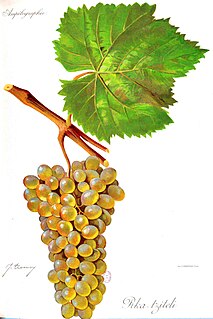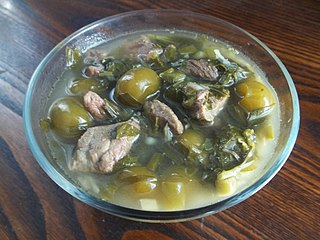Related Research Articles

A grape is a fruit, botanically a berry, of the deciduous woody vines of the flowering plant genus Vitis.

Wine is an alcoholic drink typically made from fermented grapes. Yeast consumes the sugar in the grapes and converts it to ethanol and carbon dioxide, releasing heat in the process. Different varieties of grapes and strains of yeasts are major factors in different styles of wine. These differences result from the complex interactions between the biochemical development of the grape, the reactions involved in fermentation, the grape's growing environment (terroir), and the wine production process. Many countries enact legal appellations intended to define styles and qualities of wine. These typically restrict the geographical origin and permitted varieties of grapes, as well as other aspects of wine production. Wines not made from grapes involve fermentation of other crops including rice wine and other fruit wines such as plum, cherry, pomegranate, currant and elderberry.

Vitis vinifera, the common grape vine, is a species of flowering plant, native to the Mediterranean region, Central Europe, and southwestern Asia, from Morocco and Portugal north to southern Germany and east to northern Iran. There are currently between 5,000 and 10,000 varieties of Vitis vinifera grapes though only a few are of commercial significance for wine and table grape production.

The flag of Georgia, also known as the five-cross flag, is one of the national symbols of Georgia. Originally a banner of the medieval Kingdom of Georgia, it was repopularised in the late 20th and early 21st centuries during the Georgian national revival.

Rkatsiteli is a kind of grape used to produce white wine.

Kvareli is a town in northeastern in Kakheti Province, Georgia. Located in the Alazani Valley, near the foothills of the Greater Caucasus Mountains, it was the birthplace of Georgian author Ilia Chavchavadze, whose one-storied house is preserved as a local museum.

The following outline is provided as an overview of and topical guide to wine

Georgia is one of the oldest wine regions in the world. The fertile valleys and protective slopes of the Transcaucasia were home to grapevine cultivation and neolithic wine production for at least 8000 years. Due to the many millennia of wine in Georgian history and its prominent economic role, the traditions of wine are considered entwined with and inseparable from the national identity.

Mtsvane or Mtsvane Kakhuri is a grape variety used to make Georgian wines. It is used to make white wine. It was so named to refer to the yellowish-green colouring of the ripened berries. It is often blended with Rkatsiteli to create a fruity, aromatic wine. In the Georgian language the word mtsvane means new, young and green.

Eristavi was a Georgian feudal office, roughly equivalent to the Byzantine strategos and normally translated into English as "duke". In the Georgian aristocratic hierarchy, it was the title of the third rank of prince and governor of a large province. Holders of the title were ex-officio commanders of a military 'banner', wore a distinctive dress, ring, belt and spear and rode a particular breed of horse.

Wine has been produced for thousands of years, with evidence of ancient wine production in Georgia from c. 6000 BC , West Azerbaijan province of Iran from c. 5000 BC, Armenia from c. 4100 BC, and Sicily from c. 4000 BC. The earliest evidence of a grape and rice mixed based fermented drink sometimes compared to wine was found in ancient China.

Georgian cuisine is a traditional cuisine of Georgia. Georgian cuisine has similarities with Caucasus cuisine. Every region of Georgia has its own distinct style of food preparation. Eating and drinking are important parts of Georgian culture.

Abkhazia(region in Georgia) is a cultural region in the South Caucasus. It has a long history of wine-making. Most of the produced wine is consumed locally or exported to Russia.

Georgia wine refers to wine made from grapes grown in the U.S. state of Georgia. Georgia was an important winegrowing region of the United States in the 19th century, and by 1900 ranked sixth in production among U.S. states.

Chakapuli is a Georgian stew. It is considered to be one of the most popular dishes in Georgia.

Orange wine, also known as skin-contact white wine, skin-fermented white wine, or amber wine, is a type of wine made from white wine grapes where the grape skins are not removed, as in typical white wine production, and stay in contact with the juice for days or even months. This contrasts with conventional white wine production, which involves crushing the grapes and quickly moving the juice off the skins into the fermentation vessel. The skins contain color pigment, phenols and tannins that would normally be considered undesirable for white wines, while for red wines skin contact and maceration is a vital part of the winemaking process that gives red wine its color, flavor, and texture.

Kvevri or Qvevri - also known as Tchuri in Western Georgia - are large earthenware vessels used for the fermentation, storage and ageing of traditional Georgian wine. Resembling large, egg-shaped amphorae without handles, they are either buried below ground or set into the floors of large wine cellars. Kvevris vary in size: volumes range from 20 litres to around 10,000; 800 is typical.
Vazisubani is an appellation for wines produced in a 62-square-kilometer zone around Vazisubani village in eastern Georgia.
Tvishi is an appellation for wines produced in a 15 km2 zone around Tvishi village in northwestern Georgia. The zone is on the right bank of the Rioni River and includes Alpana village.